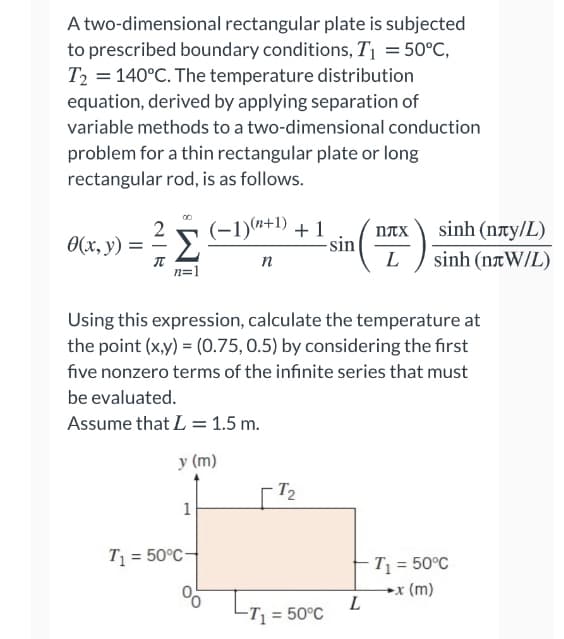(-1)(*+1) + 1 -sin L NAX sinh (nxy/L) 0(x, y) = Σ n sinh (naW/L) n=1 Using this expression, calculate the temperature at the point (x,y) = (0.75, 0.5) by considering the first five nonzero terms of the infinite series that must be evaluated. Assume that L = 1.5 m. iM:
(-1)(*+1) + 1 -sin L NAX sinh (nxy/L) 0(x, y) = Σ n sinh (naW/L) n=1 Using this expression, calculate the temperature at the point (x,y) = (0.75, 0.5) by considering the first five nonzero terms of the infinite series that must be evaluated. Assume that L = 1.5 m. iM:
Functions and Change: A Modeling Approach to College Algebra (MindTap Course List)
6th Edition
ISBN:9781337111348
Author:Bruce Crauder, Benny Evans, Alan Noell
Publisher:Bruce Crauder, Benny Evans, Alan Noell
ChapterA: Appendix
SectionA.2: Geometric Constructions
Problem 10P: A soda can has a volume of 25 cubic inches. Let x denote its radius and h its height, both in...
Related questions
Topic Video
Question

Transcribed Image Text:A two-dimensional rectangular plate is subjected
to prescribed boundary conditions, T1 = 50°C,
T2 = 140°C. The temperature distribution
equation, derived by applying separation of
variable methods to a two-dimensional conduction
problem for a thin rectangular plate or long
rectangular rod, is as follows.
(-1)*+1) + 1
-sin
L
sinh (nty/L)
sinh (naW/L)
nAX
0(x, y) = =
Σ
n
n=1
Using this expression, calculate the temperature at
the point (x,y) = (0.75, 0.5) by considering the first
five nonzero terms of the infinite series that must
be evaluated.
Assume that L = 1.5 m.
у (m)
T2
1
T = 50°C-
T = 50°C
→x (m)
L
L
-T = 50°C
Expert Solution
This question has been solved!
Explore an expertly crafted, step-by-step solution for a thorough understanding of key concepts.
This is a popular solution!
Trending now
This is a popular solution!
Step by step
Solved in 3 steps

Knowledge Booster
Learn more about
Need a deep-dive on the concept behind this application? Look no further. Learn more about this topic, advanced-math and related others by exploring similar questions and additional content below.Recommended textbooks for you

Functions and Change: A Modeling Approach to Coll…
Algebra
ISBN:
9781337111348
Author:
Bruce Crauder, Benny Evans, Alan Noell
Publisher:
Cengage Learning

Functions and Change: A Modeling Approach to Coll…
Algebra
ISBN:
9781337111348
Author:
Bruce Crauder, Benny Evans, Alan Noell
Publisher:
Cengage Learning